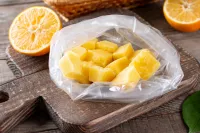A Guide to Making Sushi Rolls
Only a few components, including seafood meat like crab or prawn, avocado strips, and thinly sliced cucumber, are required to make California rolls. You will also need sushi rice and seaweed strips of nori. You may give the crab flesh a creamier texture by combining it with some mayonnaise.
You can add sliced cucumber or carrots and tuna to the essential list of preferred ingredients. Remember that when making sushi, you can't make it with any old kind of rice. Ideally it should be made with Japonica, which is primarily produced in Japan and some regions of California and Italy. When making handmade sushi rice, you want to strive for fluffy rice that is just a little bit sticky but not too sticky.
You will need a few important tools for preparing sushi:
- Makisu - A rolling mat made of bamboo or plastic
- Sharp Knife
- Plastic Wrap
Steps for Making a California Sushi Roll
Here is the most common method for rolling maki sushi, which refers to any rolled sushi. The sushi rice may be rolled on top of the seaweed strip, or the sheet of nori can be turned over so that the rice is exposed on the outside of the roll after it is completed.
- Position the rolling bamboo mat on a chopping board with the bamboo strips flowing horizontally toward you. If you don't have a bamboo mat yet, you can buy one very cheapily. You should lay down a piece of plastic wrap on top of the bamboo mat. After that, lay a sheet of nori, or half a sheet, on top of the wrapper.
- On top of the nori, take a scoop of sushi rice and evenly spread it all over. Avoid using an excessive amount of rice. With practice, you can learn to measure how much rice is necessary. We will put about a cup of rice over each complete sheet of dried seaweed and leave a tiny gap at the upper portion of the nori so that you may seal the roll. Wet your fingertips beforehand to avoid your fingers sticking together when spreading the sushi rice.
- Place the thinly sliced vegetables of choice in the middle of the dried seaweed sheet coated with rice. Be careful not to over pack it. Simply flip it over and position it so that the rice-facing side is down on the bamboo mat if you want the rice to be on the outside of the roll you are forming. After that, place the rest of the ingredients on top of the dried seaweed sheet according to your preferences.
- Gently, raise the bottom of the mat over to form the shape, apply some pressure and form them into a tube.
- Continue rolling until just about an inch of the dried seaweed is exposed at the top. Use a drop or two of cold water to close the edges. To give it more structure, tighten the mat around the roll until it is all at the same level of tightness. Be mindful not to apply so much pressure that the ingredients are squished or that they begin to seep out of the edges of the container.
- Place the sushi roll on a cutting board. You may use your knife to cut it in the appropriate size. Every time you create a slice, moisten the knife with a little water so you can achieve a clean cut. You can make up to six pieces of sushi from every roll.
- Arrange the sushi pieces neat and orderly on the trays or sushi plates. You may enjoy this dish with some wasabi, pickled ginger, soy sauce, and if you prefer, a little grated daikon.
A Variety of Recipes for Sushi Rolls
Now that you know how to create your own sushi at home, you can try any of the following at home with ease just by varying a few of the ingredients.
- Temaki
- Alaska Roll
- Spicy California Roll
- Smoked Salmon Sushi Roll
- The Dragon Roll
Sushi Cooking Questions
Is there a way to store sushi overnight?
This is not something we encourage doing since the longer you keep the fresh fish, the greater the chance of bacteria development. If you feel that you are becoming full but there are still ingredients remaining, you may want to eat the remainder of the fish, cut thinly sashimi-style, as for many, it is the fish that is the most important ingredient.
Additionally, rice that has been refrigerated becomes brittle and dry, and it does not reheat very well; for these reasons, sushi is something that should be consumed as soon as it is produced.
Is there any way to prepare sushi without using fish?
Yes, it is possible to go vegan on sushi. You may use avocados, cucumbers, and mangoes. All are excellent choices for fish alternatives.

 How to Make Ice Cream in A bag
How to Make Ice Cream in A bag How to Make Vegan Pasta
How to Make Vegan Pasta



